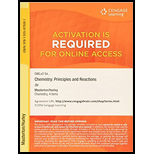
Interpretation:
The reaction that proceeds spontaneously at a lower temperature needs to be identified from the given options:
Concept introduction:
The change in the Gibbs free energy, ΔG is a
Where,
Answer to Problem 47QAP
Reaction (a)
Explanation of Solution
The chemical equation corresponding to the reaction between iron ore and hydrogen is given as:
For the above reaction, the
Step 1: Calculate
The standard enthalpy change for a reaction
i.e.
Where np and nr are the number of moles of the products and reactants
For the given reaction:
Step 2: Calculate
The standard entropy change for a reaction
i.e.
Where np and nr are the number of moles of the products and reactants
For the given reaction:
Step 3: Estimate the temperature when
When
Thus,
497 K.
The chemical equation corresponding to the reaction between iron ore and carbon is given as:
For the above reaction, the
Step 1: Calculate
The standard enthalpy change for a reaction
i.e.
Where np and nr are the number of moles of the products and reactants
For the given reaction:
Step 2: Calculate
The standard entropy change for a reaction
i.e.
Where np and nr are the number of moles of the products and reactants
For the given reaction:
Step 3: Estimate the temperature when
When
Thus,
698K.
Therefore, reaction (a) would proceed spontaneously at a lower temperature
Reaction (a) proceeds spontaneously at 497 K while reaction (b) requires a temperature of 698 K Thus, the reaction of iron ore with carbon i.e. reaction (a) will proceed spontaneously at a lower temperature relative to (b).
Want to see more full solutions like this?
Chapter 16 Solutions
Owlv2, 4 Terms (24 Months) Printed Access Card For Masterton/hurley's Chemistry: Principles And Reactions, 8th
- One of the few industrial-scale processes that produce organic compounds electrochemically is used by the Monsanto Company to produce1,4-dicyanobutane. The reduction reaction is 2CH2CHCH+2H++2eNC(CH2)4CN The NC(CH2)4CN is then chemically reduced using hydrogen gas to H2N(CH2)6NH2, which is used in the production of nylon. What current must be used to produce 150.kg NC(CH2)4CN per hour?arrow_forward4.48 Elemental phosphorous is used in the semiconductor industry. It can be obtained from an ore called fluoroapatite via reaction with SiO2 and C: 4Ca5( PO4)3F+18SiO2+30C3P4+30CO+18CaSiO3+2CaF2 Suppose a particular semiconductor production plant requires 1500 kg of P4. If the recovery of P4 from this reaction is 73% efficient, what mass of fluoroapatite is needed?arrow_forwardThree reactions very important to the semiconductor industry are The reduction of silicon dioxide to crude silicon, SiO2(s) + 2 C(s) → Si(s) + 2 CO(g) ΔrH° = 689.9 kJ/mol The formation of silicon tetrachloride from crude silicon, Si(s) + 2 Cl2(g) → SiCl4(g) ΔrH° = −657.01 kJ/mol The reduction of silicon tetrachloride to pure silicon with magnesium, SiCl4(g) + 2 Mg(s) → 2 MgCl2(s) + Si(s) ΔrH° = −625.6 kJ/mol Calculate the overall enthalpy change when 1.00 mol sand, SiO2, changes into very pure silicon by this series of reactions.arrow_forward
- Write balanced net ionic equations for the following reactions in acid solution. (a) Liquid hydrazine reacts with an aqueous solution of sodium bromate. Nitrogen gas and bromide ions are formed. (b) Solid phosphorus (P4) reacts with an aqueous solution of nitrate to form nitrogen oxide gas and dihydrogen phosphate (H2PO4-) ions. (c) Aqueous solutions of potassium sulfite and potassium permanganate react. Sulfate and manganese(II) ions are formed.arrow_forwardWrite balanced chemical equations for the following reactions. (a) The reaction of aluminum and iron(III) oxide to form iron and aluminum oxide (known as the thermite reaction). (b) The reaction of carbon and water at high temperature to form a mixture of gaseous CO and H2 (known as water gas and once used as a fuel). (c) The reaction of liquid silicon tetrachloride and magnesium forming silicon and magnesium chloride. This is one step in the preparation of ultrapure silicon used in the semiconductor industryarrow_forwardIn the commercial preparation of aluminum, aluminum oxide, Al2O3, is electrolyzed at 1000C. (The mineral cryolite is added as a solvent.) Assume that the cathode reaction is Al3+3eAl How many coulombs of electricity are required to give 3.9 kg of aluminum?arrow_forward
- Sodium perchlorate, NaClO4, is produced by electrolysis of sodium chlorate, NaClO3. If a current of 2.50 103 A passes through an electrolytic cell, how many kilograms of sodium perchlorate are produced per hour?arrow_forwardPhosphate buffers are important in regulating the pH of intracellular fluids. If the concentration ratio of H2PO4/HPO42 in a sample of intracellular fluid is 1.1: 1, what is the pH of this sample of intracellular fluid? H2PO4(aq)HPO42(aq)+H+(aq)Ka=6.2108arrow_forwardThe oxidation number of sulfur in Fe2(S2O8)3 is what?arrow_forward
 General Chemistry - Standalone book (MindTap Cour...ChemistryISBN:9781305580343Author:Steven D. Gammon, Ebbing, Darrell Ebbing, Steven D., Darrell; Gammon, Darrell Ebbing; Steven D. Gammon, Darrell D.; Gammon, Ebbing; Steven D. Gammon; DarrellPublisher:Cengage Learning
General Chemistry - Standalone book (MindTap Cour...ChemistryISBN:9781305580343Author:Steven D. Gammon, Ebbing, Darrell Ebbing, Steven D., Darrell; Gammon, Darrell Ebbing; Steven D. Gammon, Darrell D.; Gammon, Ebbing; Steven D. Gammon; DarrellPublisher:Cengage Learning Chemistry: The Molecular ScienceChemistryISBN:9781285199047Author:John W. Moore, Conrad L. StanitskiPublisher:Cengage Learning
Chemistry: The Molecular ScienceChemistryISBN:9781285199047Author:John W. Moore, Conrad L. StanitskiPublisher:Cengage Learning Chemistry for Engineering StudentsChemistryISBN:9781337398909Author:Lawrence S. Brown, Tom HolmePublisher:Cengage Learning
Chemistry for Engineering StudentsChemistryISBN:9781337398909Author:Lawrence S. Brown, Tom HolmePublisher:Cengage Learning Living By Chemistry: First Edition TextbookChemistryISBN:9781559539418Author:Angelica StacyPublisher:MAC HIGHER
Living By Chemistry: First Edition TextbookChemistryISBN:9781559539418Author:Angelica StacyPublisher:MAC HIGHER
 Chemistry: An Atoms First ApproachChemistryISBN:9781305079243Author:Steven S. Zumdahl, Susan A. ZumdahlPublisher:Cengage Learning
Chemistry: An Atoms First ApproachChemistryISBN:9781305079243Author:Steven S. Zumdahl, Susan A. ZumdahlPublisher:Cengage Learning





